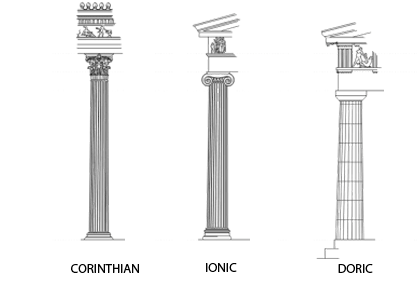
A column is a vertical structural element that supports weight. Columns support weight through compression and hold up beams or entablatures to transfer weight. In ancient times columns represented a person with a base (foot), shaft (trunk) and capital (head). Greek architecture gave us the first three orders: Doric from the Dorian peninsula is male; Ionic from Ionia is a neutral gender; and Corinthian from Corinth represents a young maiden. The Roman architect Vitruvius recorded the origins, proportions and intercolumniation (spacing) of the orders, adding Tuscan and Composite orders. Renaissance architects regularized the proportions of the orders, all based on the module or width of the base of the column. Columns were originally made of wood, stone, or marble, but today are also made of steel, brick, concrete and glass!
Activity 1 – Build A Structural Column

Columns support weight. What kind of column could support your weight? Using simple materials from around your house (toilet paper tubes, tape, sand), construct an experiment to learn what helps a column gain strength, to see compression in action and to learn how loads are transferred.
Place an empty toilet paper tube on the floor in a pan. Carefully holding a chair for balance, gradually step onto the tube. Continue to increase weight until the tube collapses.
Take a second tube and wrap the tube with tape and fill it with sand. Step onto this tube and gradually increase your weight. What happens?
Activity 2 – Column Capture

Take a 15 minute walk around your neighborhood with a digital camera. Take pictures of as many different column capital types as you can find. Print your capital pictures and identify the order.
Activity 3 – Draw the 3 Orders

Wood and stone were the materials of the first columns. Columns were vertical members which supported horizontal or raked(sloped) members to construct a primitive shelter. In the Classical Language of Architecture, craftsmen created orders which represented genders of the Greek gods and goddesses. The Doric order by the Dorians, the Ionic by the Ionians, and the Corinthian by the Corinthians, all expressed part to whole expressions of structure and ornament working together. Look at the Doric Capital and Entablature and draw and label its parts. Look at the Ionic Capital and Entblature and draw and label its parts.And finally, study the most ornate of the three Greek Orders, [the Corinthian Capital and Entablature](http://rocbo.lautre.net/archi/arch_drawing/118-119.html] and draw and label its parts. As you handle the scale and proportion of the parts, imagine how difficult it would be to carve these shapes out of stone!!
Activity 4 – Create Your Own Capital
The capital of a column represents the human head. But capitals all over the world have been created to deliver other messages as well. Some are adorned with nature patterns, animals and geometric shapes. In this activity, you can imagine your own capital. What will you put on it? Be sure to give it three parts: the abacus (looks like a pizza box in shape), the echinus (looks rounded and is under the abacus) and the necking (the part which is the most slender and which connects the capital to the shaft).
Paper Column: Decide what sculptural relief you want to use. Find an old can and cover it with stiff paper. Cut and paste cut out shapes to build up your column capital. Draw an elevation of your capital. Try to shade the capital so that it shows the 3-dimensions of your creation. Make a copy and paste into your journal.
Clay Capital: In this stage, you can mold your capital out of modeling clay. Turn it around to see it from all sides. If it seems difficult, remember that most capitals were carved out of stone! Take a digital picture of your capital and submit it to the NEXT gallery!
Activity 5 – Columns Today
Columns today are made with more materials than wood and stone. Heavy timber construction, once feared for destruction by fire, is returning to urban areas; heavy timber chars but actually lasts longer than other fire rated and fire protected materials such as aluminum and steel. Stone columns, which took millennia to compress its strength, are not the material of choice due t expense. Concrete, and reinforced concrete columns and rigid frames are viable alternatives, yet steel columns supporting steel beams expanded tall buildings around the world the quickest. Research heavy timber framing, steel framing, and concrete framing for ease of construction and cost and speed of construction. Make a chart for columns/frames with each of these materials.
Review

- Which structural force involves crushing or compaction?
- What are the classical orders?
- What are the parts of a column?
- What materials can be used to make columns?
- Think of two buildings on your block that use columns:
Explore
Relate
- 7 Natural Wonders
- Architecture
- Architecture and Music
- Beams
- Bridges
- Buildings like Bodies
- Building Types
- Classical Language
- Columns
- Detail
- Digital Modeling
- Facade Elements
- Greek Architecture
- Historic Preservation
- Material Matters
- Proportion
- Rhythm
- Roman Architecture
- Scale
- Sculpture
- Space
- Structure
- symmetry
- Trusses
- Walls
- Wall Sections
- Wood



















































